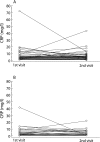C-reactive protein in patients with COPD, control smokers and non-smokers
- PMID: 16143583
- PMCID: PMC2080714
- DOI: 10.1136/thx.2005.042200
C-reactive protein in patients with COPD, control smokers and non-smokers
Abstract
Background: Patients with chronic obstructive pulmonary disease (COPD) have raised serum levels of C reactive protein (CRP). This may be related directly to COPD and its associated systemic inflammation or secondary to other factors such as concomitant ischaemic heart disease (IHD) or smoking status. The aim of this study was to evaluate IHD and smoking as potential causes of raised CRP levels in COPD and to test the association between inhaled corticosteroid (ICS) use and serum CRP levels.
Methods: Cross sectional analyses comparing cohorts of 88 patients with COPD, 33 smokers (S), and 38 non-smoker (NS) controls were performed. Clinical assessments included a complete medical history, pulmonary function, 6 minute walk test (6MWT), cardiopulmonary exercise test, and high sensitivity serum CRP measurements.
Results: Serum CRP levels were significantly higher in patients with COPD (5.03 (1.51) mg/l) than in controls (adjusted odds ratio 9.51; 95% confidence interval 2.97 to 30.45) but were similar in the two control groups (S: 2.02 (1.04) mg/l; NS: 2.24 (1.04) mg/l). There was no clinical or exercise evidence of unstable IHD in any of the subjects. CRP levels were lower in COPD patients treated with ICS than in those not treated (3.7 (3.0) mg/l v 6.3 (3.6) mg/l); this association was confirmed in an adjusted regression model (p<0.05).
Conclusion: CRP levels are raised in COPD patients without clinically relevant IHD and independent of cigarette smoking, and reduced in patients with COPD using ICS. CRP may be a systemic marker of the inflammatory process that occurs in patients with COPD.
Conflict of interest statement
Competing interests: none declared.
Comment in
-
Skeletal muscle weakness, reduced exercise tolerance, and COPD: is systemic inflammation the missing link?Thorax. 2006 Jan;61(1):1-3. doi: 10.1136/thx.2005.044941. Thorax. 2006. PMID: 16396949 Free PMC article.
References
Publication types
MeSH terms
Substances
LinkOut - more resources
Full Text Sources
Other Literature Sources
Medical
Research Materials
Miscellaneous




